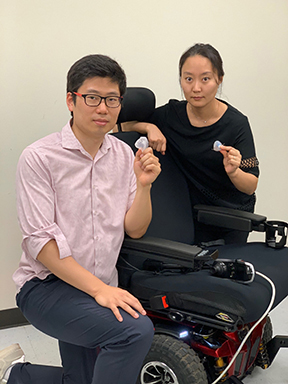
In 2017 it was estimated that there were nearly 4.2 million veterans with service-connected disabilities, many of whom required housing assistance in one form another to be able to live independently. Among these are about 42,000 veterans with severe spinal cord injuries and disorders. Researchers at Texas A&M University are working on new technology that could help these veterans achieve even more independence.
The Department of Veterans Affairs (VA) oversees a program offered to veterans and service members with certain service-connected disabilities called Specially Adapted Housing (SAH), which provides funds to modify or construct an adapted home to meet their needs. Typical adaptations include ramps, wider halls and doors, or wheelchair-accessible bathrooms.
But there are many other emerging technologies that could improve home adaptions or enhance a veteran or service member's ability to live independently, such as voice-recognition and voice-command operations, living environment controls and adaptive feeding equipment. The VA has defined this as new assistive technology (AT), an advancement that could aid or enhance the ability of a veteran or service member to live in an adapted home.

To help improve this new assistive technology, the VA is awarding Specially Adapted Housing Assistive Technology (SAHAT) Grants. Dr. Hangue Park, assistant professor in the Department of Electrical and Computer Engineering, along with Dr. Jeonghee Kim, assistant professor in the Department of Engineering Technology and Industrial Distribution, have received a $200,000 SAHAT grant to work on their own assistive technology device.
Park said he and Kim had been working on types of assistive technology since their doctoral studies 10 years ago, but it wasn’t enough. “We were not satisfied with what we did and we think there is still a long way to go for ATs for severely disabled individuals,” he said.
Park said most people with quadriplegia still depend on old assistive technologies such as the sip’n’puff, head-switch and mouth-stick in spite of their limited functionality and accessibility.
“It is mainly because they are intuitive, robust, easy-to-use and price competitive,” he said. “However, those basic ATs do not support multiple commands and cannot handle multiple devices such as computers, powered wheelchairs and smartphones. Indeed, a considerable effort has been put out to develop advanced ATs for people with quadriplegia. However, one of the main reasons that advanced ATs fail in the market is because they’re difficult to operate or learn. As advanced ATs have versatile functionalities with a more complex operating principle, command intuitiveness becomes more and more important to reduce the cognitive burden.”
To address this issue and make the advanced and intuitive AT available, the researchers proposed a new Multifunctional intraORal Assistive technology (MORA). MORA employs intuitive intraoral (occurring within the mouth) commands and motion-dependent sensory feedback to make the advanced ATs more convenient and easier to use. Park said the intraoral function is intact for most people even after a high-level spinal cord injury because intraoral organs are designed to perform sophisticated and repetitive motor tasks, and motion-dependent sensory feedback is crucial for the new motor learning.
“MORA will be easily accepted by people with quadriplegia and promote their sustained functional independence as a one-stop shop to control multiple devices and intuitive interface to the environment with minimal cognitive burden,” he said.
Park is excited about working on MORA and credits much of their ability to pursue this research to the environment at Texas A&M.
“Texas A&M University provides a great research environment for me and (Kim). Our department heads, Dr. Miroslav Begovic and Dr. Reza Langari, are extremely supportive to assistant professors, which truly helps us to pursue our research,” Park said. “Also, Texas A&M provides a great research environment to pursue spinal cord injury research. Under the leadership of Dr. James Grau, faculty in the Texas A&M Spinal Cord Initiative help each other with the same objective of improving the quality of life for people with a spinal cord injury. I feel privileged to work as a part of Texas A&M Spinal Cord Initiative. It is really a family-like environment and makes a great synergy among faculty in multiple disciplines.”
Park was pleased to receive the grant and do his part to help veterans, and adds that their new device will not be limited to veterans with spinal cord injuries because the same technology can be generally applied to veterans with other severe disabilities.
“Veterans should be taken care of with special attention, as a way to appreciate their sacrifice for the nation and other people,” Park said. “(Kim) and I very much appreciate this opportunity from the United States Department of Veterans Affairs and are looking forward to contributing to improve the quality of life for veterans.”